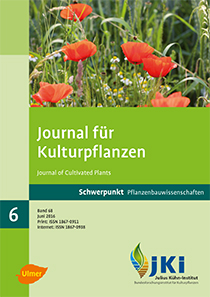Seed dormancy in F<sub>1</sub> and F<sub>2</sub> generations of imidazolinone-tolerant oilseed rape at different locations
Keywords:
Clearfield, Brassica napus, volunteers, secondary dormancy, maternal environment, precipitation, hybridsAbstract
The introduction of imidazolinone-tolerant oilseed rape (Brassica napus; Clearfield®, CL OSR) meets with skepticism on volunteer control. This study examined the disposition to secondary seed dormancy of 15 CL OSR genotypes at two locations in south-west Germany in 2012/2013 (trial 1) between sown seed (F1) and harvested seed (F2), and effects of maternal environment on dormancy disposition on CL and non-CL OSR in 12 locations in Germany in 2011/2012 (trial 2). The CL genotypes differed in dormancy from 0 to 95.7% in the F1 generation and from 3.5 to 77.9% for their corresponding offspring (F2). The dormancy levels of the F1 generations corresponded to that of the F2 generations. This correlation was higher if seeds derived from flowers which have been isolated in the plastic bags and thus outcrossing has been prevented. Seed lots from individual isolated F1 plants deviated in dormancy by up to 30% from the mean of all isolated plants of a specific genotype. In trial 2, seeds from low dormancy genotypes tended to respond more strongly to maternal environment than high dormancy genotypes did. Precipitation during the period of ripening was positively correlated with dormancy (R = 0.78). Overall, breeders can use the dormancy values of the F1 generation to assess the potential of dormancy in their offspring, which are those seeds that are relevant for causing volunteers if several other external conditions are fitting.
DOI: 10.5073/JfK.2016.06.03, https://doi.org/10.5073/JfK.2016.06.03
Published
Issue
Section
License
The content of the journal is licensed under the Creative Commons Attribution 4.0 License. Any user is free to share and adapt (remix, transform, build upon) the content as long as the original publication is attributed (authors, title, year, journal, issue, pages).
The copyright of the published work remains with the authors. The authors grant the Journal of Cultivated Plants, the Julius Kühn-Institut and the OpenAgrar repository the non-exclusive right to distribute and exploit the work.







